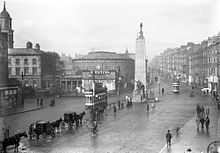| Dublin tramways | |
|---|---|
 The last DUTC tram to run in Dublin city, needed police protection from souvenir hunters on its final trip to the Blackrock Depot | |
 Trams passing the Parnell monument in 1913 | |
| Overview | |
| Locale | Dublin, Ireland |
| Transit type | trams |
| Number of lines | 23 (1928) |
| Annual ridership | 88,530,737 (1937) |
| Operation | |
| Began operation | 1872 |
| Ended operation | 1949 |
| Operator(s) | Dublin United Tramways Company |
| Technical | |
| System length | over 60 mi (97 km) |
Dublin tramways was a system of trams in Dublin, Ireland, which commenced line-laying in 1871, and began service in 1872, following trials in the mid-1860s.[1] Established by a number of companies, the majority of the system was eventually operated by forms of the Dublin United Tramways Company (DUTC), dominated for many years by William Martin Murphy. Most of the services ran within the city centre and near suburbs, with the majority of major suburbs served (and many of the remainder handled by mainline rail). Additionally, there were two longer-range services, one reaching the "excursion" destination of Poulaphouca Falls, and two services concerning Howth.
At its peak, with over 60 miles (97 km) of active line, the system was heavily used, profitable and advanced in technology and passenger facilities, with near-full electrification complete from 1901. Heavy usage lasted from the late 19th century into the 1920s. The tram system was also central to the Dublin Lockout, which caused major distress within the city.
Elements of the system went out of service from the mid-1920s, in part overtaken by the bus.[2] The decline of the trams accelerated in the 1940s and the last trams ran on 9 July 1949 in Dublin city[3] and in 1959 on Howth Head, near Dublin.[4]
- ^ Thacker, Andrew (2 May 2003). The Hibernian metropolis. Manchester University Press. ISBN 9780719053092. Retrieved 10 July 2008.
- ^ Cite error: The named reference
Clontarfwas invoked but never defined (see the help page). - ^ Cite error: The named reference
Dalkey tramwas invoked but never defined (see the help page). - ^ Cite error: The named reference
Tram historywas invoked but never defined (see the help page).
